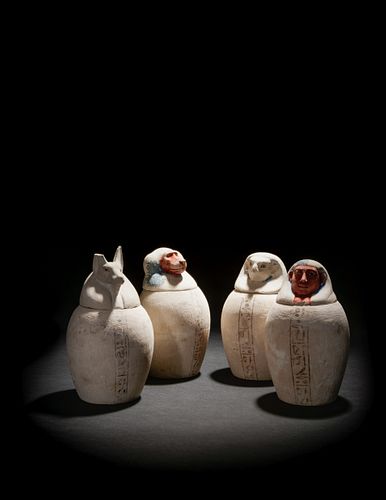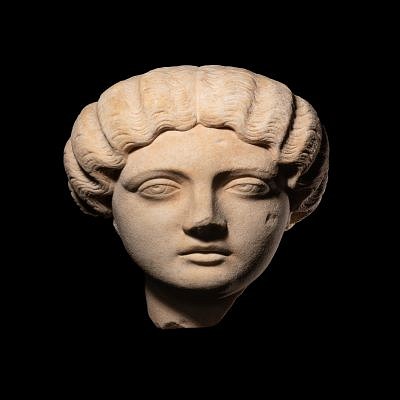A Set of Four Egyptian Painted Limestone Canopic Jars of the Sons of Horus Height of tallest example 10 1/4 inches.
Lot 31
About Seller
Hindman
1338 West Lake Street
Chicago, IL 60607
United States
Recognized as the Midwest's leading fine art auctioneers, Hindman Auctioneers has built a worldwide reputation based on a full service approach to the auction business tailored to meet the individual needs of our clients. Coming from a variety of educational backgrounds, specialists bring years of e...Read more
Categories
Estimate:
$30,000 - $50,000
Absentee vs Live bid
Two ways to bid:
- Leave a max absentee bid and the platform will bid on your behalf up to your maximum bid during the live auction.
- Bid live during the auction and your bids will be submitted real-time to the auctioneer.
Bid Increments
| Price | Bid Increment |
|---|---|
| $0 | $25 |
| $500 | $50 |
| $1,000 | $100 |
| $2,000 | $250 |
| $5,000 | $500 |
| $10,000 | $1,000 |
| $20,000 | $2,500 |
| $50,000 | $5,000 |
| $100,000 | $10,000 |
About Auction
By Hindman
Nov 23, 2020
Set Reminder
2020-11-23 11:00:00
2020-11-23 11:00:00
America/New_York
Bidsquare
Bidsquare : Antiquities, Islamic & Indian Art
https://www.bidsquare.com/auctions/hindman-auctions/antiquities-islamic-indian-art-5912
Hindman Bidsquare@hindmanauctions.com
Hindman Bidsquare@hindmanauctions.com
- Lot Description
A Set of Four Egyptian Painted Limestone Canopic Jars of the Sons of Horus
New Kingdom, Dynasty 18, 1550-1307 B.C.
Height of tallest example 10 1/4 inches.
Note:
Canopic jars were used to contain the viscera, or internal organs, of the deceased. During the process of mummification, the liver, lungs, stomach and intestines were removed from the body and embalmed separately in a set of four jars, which were ultimately interred in the burial chamber with the coffin. During the Middle Kingdom, the lids of canopic jars featured human heads, but during the New Kingdom, specific organs came to be associated with the Four Sons of Horus, who were appointed by their father as guardians of the excised organs in the context of the process of mummification and the Afterlife: the liver with human-headed Imsety; the lungs with baboon-headed Hapy; the stomach with jackal-headed Duamutef and the intestines with falcon-headed Qebehsenuef (D'Auria, Lacovara and Roehrig, Mummies and Magic: The Funerary Arts of Ancient Egypt, Boston, 1988, p. 151).
Each jar in the present set is inscribed in hieroglyphs with the name of the deceased, Ipu, and the name of the depicted Son of Horus. The name Ipu was common among both men and women at the time, but the determinatives at the end of the inscriptions are male, which likely indicate the sex of the dedicatee.
Provenance:
Bruce McAlpine Ancient Art, 1 December 1992 (with invoice).
Property from the Estate of Joan Conway Crancer, St. Louis, MissouriCondition
For condition inquiries please contact fdcr@hindmanauctions.com - Shipping Info
-
Please refer to https://hindmanauctions.com/shipping-packing
-
- Buyer's Premium



 EUR
EUR CAD
CAD AUD
AUD GBP
GBP MXN
MXN HKD
HKD CNY
CNY MYR
MYR SEK
SEK SGD
SGD CHF
CHF THB
THB





















![[CIVIL WAR] Full Plate Tintype of Double-Armed Soldier](https://s1.img.bidsquare.com/item/m/2900/29009533.jpeg?t=1TrhnO)
